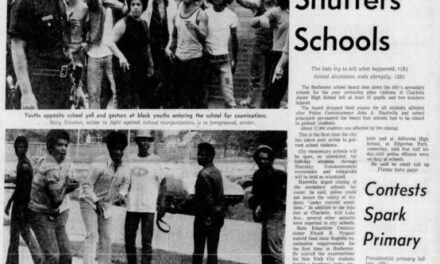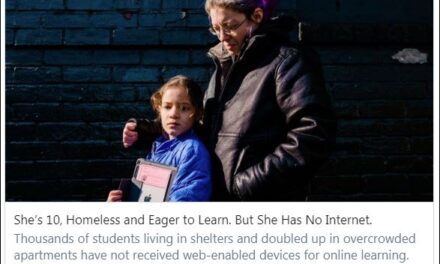There’s no simple answer when vulnerable sources are harmed by being named in archived stories, notes contributor Danielle Dreilinger.
By Danielle Dreilinger
The student was enthusiastic about participating in the story: an in-depth profile outlining their fight to come back from devastating setbacks, including poverty and violence. I put a lot of time into the storytelling and believed it was among my best work. Readers cheered this teenager’s determination to overcome systemic and personal challenges. Some even offered money. As was the paper’s policy, I used the student’s full name and did not cloak identifying details.
But time passes. A few years later, the former student called me, upset. They had moved on. But the story had followed them.
In an earlier time, it would have crumbled into dust and frozen into microfilm, hidden in a library cabinet — what University of North Carolina doctoral candidate Deborah Dwyer refers to as “practical obscurity.” Now it came up when you Googled their name. They were trying to establish themselves professionally, and business competitors had circulated the story trying to embarrass them about their difficult childhood. Not unreasonably, they asked me to take the story down.
I felt sick. Like doctors, journalists writing about vulnerable people are supposed to first do no harm. I asked my former editors if the piece could be unpublished or de-indexed — that is, embedded with code that would keep it from being found on Google searches. They said no.
Requests for taking down perfectly accurate, previously published stories are increasingly becoming a newsroom reality. So far, the issue has affected mostly the subjects of crime stories, such as arrestees who were never charged. But education journalists can expect requests such as the one I received, as the students they quote or profile grow into adulthood and find that those old stories are causing new problems in their lives.
Which leaves newsrooms with a conundrum. With internet stories lasting a lifetime or more, journalists have yet to come up with an agreed-upon strategy for preserving our “first drafts of history” while protecting innocent people from unintended long-term harm.
I’m no different. This column has more questions than answers.
The student was enthusiastic about participating in the story… As was the paper’s policy, I used the student’s full name and did not cloak identifying details. — Danielle Dreilinger
Unpublishing goes against the journalistic grain.
“Deleting truthful, previously published information places a news organization at odds with traditional ethical news values,” wrote University of Florida journalism telecommunications professor Jasmine McNealy in a 2018 journal article, “A Framework for Unpublishing Decisions.”
If we stand on our principles as truth tellers, we might contravene the Society of Professional Journalists ethic to “minimize harm.” But if we take a story down, we might let news subjects whitewash their reputations.
I lean toward the argument that we owe the vulnerable subjects of education stories some protection against unfair trouble down the road. But even if that’s true, what should we do? Remove entire stories? Take other, less draconian steps to edit after the fact?
At this time, “there is only a set of unsatisfying and imperfect alternatives,” Frank LoMonte, director of the Brechner Center for Freedom of Information, said in a phone interview.
In 2018, UNC’s Dwyer surveyed newsrooms to learn about their takedown policies. Eighty percent had unpublishing policies, according to a September write-up in Nieman Lab.
Cleveland.com’s unpublishing committee, highlighted in an August Radiolab episode, has granted 50 to 80 percent of the unpublishing requests it has received, Cleveland.com editor Chris Quinn told The Grade.
But at many news outlets, Dwyer found that unpublishing policies are often essentially secret. Almost half the newsrooms with such policies had not written them down. When outlets did take down a story, many did not update the page with a note about the removal.
Moreover, 40 percent of respondents found out about the policy “only when an issue arose,” Nieman Lab reported. Almost none of the newsrooms shared the policy with the general public.
UNC’s Dwyer found that one-quarter of unpublishing requests concerned topics other than crime. However, Cleveland.com education reporter Patrick O’Donnell said he had never dealt with unpublishing “or even heard much about it.” Editor Quinn said the committee had received no such requests beyond stories reporting a few “college antics.”
But I expect more to come. Like the subject of my article, many students who might later regret seeing their stories in print haven’t committed crimes. They’ve simply given insight into their lives. Dwyer called it “source remorse.”
LoMonte considers such people the most deserving of journalists’ sympathy. They have done nothing more than “bare their soul,” he said.
Follow The Grade on Twitter and Facebook to learn more about how the media covers education.
I asked my former editors if the piece could be unpublished or de-indexed — that is, embedded with code that would keep it from being found on Google searches. They said no. — Danielle Dreilinger
So what should education reporters do?
First, if a former source contacts you about unpublishing, “your responsibility is not to blow them off,” LoMonte said. “If you make a decision that you think is a difficult judgment call not to unpublish a story, then I think you should make some good-faith attempt to explain why.”
The University of Florida’s McNealy wrote in her journal article that news organizations should consider unpublishing only when the subject “is at risk of possible harm.” In an interview, she said that can mean a threat of physical, emotional, reputational or economic harm — inability to get a job, for instance — “but it has to be actual, real harm.”
Even if someone is at risk, McNealy says that news organizations must balance that concern against the news value of the information. “I’m saying they need to weigh these things out. What is the actual threat, what is the possible harm, what is the sensitivity of the information and what is the context of that information?”
Beyond this point, opinions diverge widely.
UNC’s Dwyer said news organizations should set unpublishing policies and make them clear to readers and staff. Outlets should track unpublishing requests and decisions and make those decisions via committee as Cleveland.com, the online portal to the Cleveland Plain Dealer, does. If they delete something, maintain the link and “notify the reader that something has been removed,” Dwyer said.
But the Brechner Center’s LoMonte is wary of standardized guidance. Not only is it difficult to make categorical rules, he said, but creating an industry standard opens news outlets to negligence lawsuits if they don’t do what other outlets are doing. And a published policy might lead people to expect outlets to unpublish on demand, he said.
In many cases, unpublishing might not mean that the story goes away. Deleting a story from a single outlet’s website doesn’t erase news that’s already traveled far and wide online.
In some cases, however, a takedown might mean that the story is lost forever. The Tow Center for Digital Journalism found 19 of 21 newsrooms did not archive their web content, according to a March report in the Columbia Journalism Review. Which means that deleting a story from a website deletes it, period. That’s a big problem for both the news record and our future research ability as reporters, not to mention our clip portfolio.
Since Dwyer began studying unpublishing, she has gone back and forth on its advisability, she said. “Where I have landed is news organizations should not unpublish because it is a slippery slope and it opens the door to too many opportunities” for corruption, censorship, and future public harm. “Our digital footprints are only going to deepen … We’re going to have to deal with some of the consequences.”
LoMonte described himself as conflicted on the issue. An ordinary person’s past may become a matter of public interest later on. Other people in the piece “may be very proud of it,” he said. And the writer may need the sample to get future jobs. He thinks newsrooms should allow occasional “mercy cases” but not routinely grant takedown requests.
“Unpublishing is not a victimless crime,” he said.
Each week, The Grade takes a deeper look at education journalism. Sign up for the free newsletter.

This Radiolab segment was featured on “On The Media” last weekend.
There are other steps journalists can think about, short of removing an entire story as if it had never existed.
For one thing, it can be updated. That’s the Washington Post’s approach. The newspaper never takes down stories altogether, according to its online policies and standards page. However, “there may be situations in which fairness demands an update or follow-up coverage,” the policy says. Post spokeswoman Molly Gannon declined to clarify.
Outlets that write a follow-up story should link to it from the original, Dwyer said. Paradoxically, updating a story–say, to link in an update or add the information that someone’s conviction was expunged—may pop it back to the top of a list of Google results, increasing its visibility.
Speaking of Google, there is code that can be embedded in webpages to keep them from coming up in searches, a process known as “de-indexing.” Indeed, ProPublica found that Intuit and H&R Block deliberately did this to hide their free-file options. It’s not as clear, however, that Google will easily forget a story once it’s already appeared in search, according to an article by a digital marketing firm that Dwyer shared.
Without a clear answer to how to handle requests for unpublishing, perhaps we should think more about reducing the chances that a source will later ask for a story to be removed.
For example, LoMonte and Dwyer suggested that newsrooms set down rules for obtaining fully informed consent before proceeding with an on-the-record interview with vulnerable people. Sources, and parents in the case of children, would be informed that these stories will likely live on.
But such conversations can go too far, scaring off sources who play key roles in important stories, Dwyer said.
Another possibility is to omit students’ last names and identifying details. The majority of people Dwyer studied considered this a good idea in theory but had yet to put it into practice, she wrote in an email. However, Marta Jewson, education reporter at New Orleans’ The Lens, offers students the option of publishing their first names only. She was influenced by a 2016 workshop in which NPR editors urged education reporters to consider leaving out last names, she said.
“Is the last name of a subject actually going to make a story better?” Jewson said. “Often, we’ll use the last name of the parent, or the parent’s full name, and we won’t use the last name of the student because it just oftentimes does not seem to be necessary.”
In those conversations with sources, “We try to explain this is something that could live on the internet forever, and [let them] think about that,” Jewson said. No readers have raised problems with the practice and she can’t recall any sources who backed out as a result, she said.
If you do omit identifying information, explain why in the story, Dwyer advises: for instance, “Outlet Name omits students’ last names to protect their privacy.”* Jewson doesn’t currently do that “but that would be a good idea to explore,” she said.
*Dwyer is currently surveying the general public to find out what they think of unpublishing.

This recent New York Times story notes: “Because of their age and the situations involved, The New York Times has granted partial anonymity to some people. We have confirmed details with parents or schoolmates.”
Despite the challenges, education journalists can no longer ignore the ethical dilemmas around online perpetuity, LoMonte said.
“I definitely don’t think that journalists can adopt a cavalier attitude that ‘the consequences of my stories are not my problem,’ ” LoMonte said.
I can’t help the former student I interviewed. But we can all have more of these conversations, earlier in the reporting process. I certainly plan to do so.
Related posts
Chalkbeat To Roll Out New Code Of Ethics
PBS NewsHour Issues On-Air Apology Over Success Academy Segment
Why gun violence journalism needs graphic images
ABOUT THE AUTHOR

Danielle Dreilinger
Danielle Dreilinger is a New Orleans–based reporter writing a book on the history and future of home economics. Follow her at @djdreilinger.















